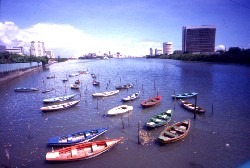Advertising by Google
Recife, Pernambuco
Area: 218,7 km²
Population: 1.378.087 inhab. (est. 2000)
See Map of Pernambuco.
Weather in Recife.
The name Recife is the Portuguese for "reefs". There are reefs along the Brazilian coast from the eastern coast of Rio Grande do Norte to the northern part of Bahia.
In the early stages of the History of Pernambuco, the main city was Olinda, which was strategically built on the top of hills, further from invasors coming from the sea; Recife was only the port through which the production of sugar was exported.
From 1630 to 1654, Pernambuco was invaded and ruled by the Dutch; accustomed to the flat lands of Holland, the Dutch moved the administrative center to Recife, which ever since never lost the status of one of the most important cities in Brazil.
Recife is known as the "Venice of Brazil" on account of its bridges, canals and rivers - in the centre of the city alone there are 39 bridges crossing more than 50 canals, many of which built by the Dutch.
 The capital of Pernambuco is a mixture of past and present. Hidden behind a wall of modern buildings lies the Patio de São Pedro, comprising colonial houses of the eighteenth and nineteenth centuries around the cathedral of São Pedro. The old prison has been converted into a popular culture centre, with shops selling fabrics, carpets, items of rope and straw, embroidery and pottery.
The capital of Pernambuco is a mixture of past and present. Hidden behind a wall of modern buildings lies the Patio de São Pedro, comprising colonial houses of the eighteenth and nineteenth centuries around the cathedral of São Pedro. The old prison has been converted into a popular culture centre, with shops selling fabrics, carpets, items of rope and straw, embroidery and pottery.
The carnival of Recife and Olinda are probably the most popular in Brazil; famous and anonymous people meet in the streets to dance to the sound of frevo, a rythm which is forever associated with Pernambuco. During Carnival, the Galo da Madrugada (Rooster of the Dawn) opens the proceedings and brings over one million people onto the streets - the group has entered the Guinness Book of Records as the largest Carnival group in the world.
In the capital of Pernambuco, art and culture permeate life and are reflected in the colonial architecture of the houses, churches and old forts. In the Museu do Homem do Nordeste - Museum of Man of the North East of Brazil, an important collection takes the visitor back to the past, to the height of the sugar era and to the best of Pernambucan popular art. On the banks of the Capibaribe river, 16 kilometres from Recife, is the workshop and museum of the artist Francisco Brennand, in an old sugar mill which he has renovated. The museum is also called the "Cathedral of Art", and 2,000 works by the artist are on show there. Check out this list of Museums in Recife and Olinda.
Recife has an important historic patrimony, represented by ancient buildings, mainly in the XVII to XIX centuries, such as big houses, wonderful baroque architecture churches, such as Capela Dourada (Dourada Chapel), and the fortresses which protected the city. The museums exhibits its luxurious culture and not only the local history.

Carnival in Olinda
The typical cookery of Pernambuco, where you can find specialties from the coastline and from the backland of the state, is one of the most significant of Brazil. Besides the dishes prepared with seafoods, such as fish stews, there's also ox, lamb, goat and chicken meats, always strongly flavored. The quantity and diversity of restaurants give to Recife the title of third gastronomical center in Brazil (behind São Paulo and Rio de Janeiro).
There are urban beaches and a blue sea which forms a wonderful scenery. Boa Viagem is the most crowded, and has calm natural pools on the strip between the land and the reefs; read more about the beaches of Recife. The eventual presence of sharks on the open sea requires the swimmers' attention, and they shouldn't go ahead of the reef barrier.
Read more:
 Recife official site. Published by the city government.
Recife official site. Published by the city government.
 Recife Guide. Cultural and travel information about Recife and other cities of Pernambuco. In English.
Recife Guide. Cultural and travel information about Recife and other cities of Pernambuco. In English.
 Universidade Federal de Pernambuco. The Federal University of Pernambuco, campus in Recife.
Universidade Federal de Pernambuco. The Federal University of Pernambuco, campus in Recife.
Back to Top